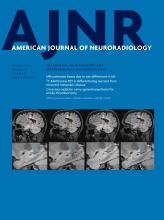Abstract
BACKGROUND AND PURPOSE: Dose reduction on CT scans for surgical planning and postoperative evaluation of midface and orbital fractures is an important concern. The purpose of this study was to evaluate the variability of various low-dose and iterative reconstruction techniques on the visualization of orbital soft tissues.
MATERIALS AND METHODS: Contrast-to-noise ratios of the optic nerve and inferior rectus muscle and subjective scores of a human cadaver were calculated from CT with a reference dose protocol (CT dose index volume = 36.69 mGy) and a subsequent series of low-dose protocols (LDPs I–4: CT dose index volume = 4.18, 2.64, 0.99, and 0.53 mGy) with filtered back-projection (FBP) and adaptive statistical iterative reconstruction (ASIR)-50, ASIR-100, and model-based iterative reconstruction. The Dunn Multiple Comparison Test was used to compare each combination of protocols (α = .05).
RESULTS: Compared with the reference dose protocol with FBP, the following statistically significant differences in contrast-to-noise ratios were shown (all, P ≤ .012) for the following: 1) optic nerve: LDP-I with FBP; LDP-II with FBP and ASIR-50; LDP-III with FBP, ASIR-50, and ASIR-100; and LDP-IV with FBP, ASIR-50, and ASIR-100; and 2) inferior rectus muscle: LDP-II with FBP, LDP-III with FBP and ASIR-50, and LDP-IV with FBP, ASIR-50, and ASIR-100. Model-based iterative reconstruction showed the best contrast-to-noise ratio in all images and provided similar subjective scores for LDP-II. ASIR-50 had no remarkable effect, and ASIR-100, a small effect on subjective scores.
CONCLUSIONS: Compared with a reference dose protocol with FBP, model-based iterative reconstruction may show similar diagnostic visibility of orbital soft tissues at a CT dose index volume of 2.64 mGy. Low-dose technology and iterative reconstruction technology may redefine current reference dose levels in maxillofacial CT.
ABBREVIATIONS:
- ALADA
- As Low As Diagnostically Achievable
- ALARA
- As Low As Reasonably Achievable
- ASIR
- adaptive statistical iterative reconstruction
- CNR
- contrast-to-noise ratio
- CTDIvol
- CT dose index volume
- FBP
- filtered back-projection
- HU
- Hounsfield unit
- IRM
- inferior rectus muscle
- LDP
- low-dose protocol
- MBIR
- model-based iterative reconstruction
- ON
- optic nerve
- © 2017 by American Journal of Neuroradiology












